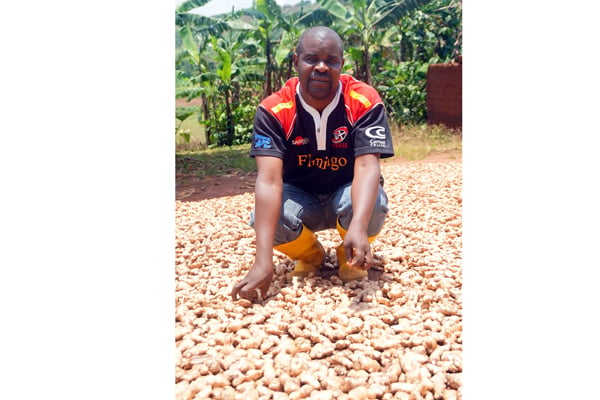Prime
Kiggundu’s fortune from ginger

Kiggundu has expanded his ginger farm. Photo/Phionah Nasanga
What you need to know:
- Ginger is used in a range of products from foods to drinks. It is also known for its healing properties, thus making it a valuable crop with high demand both on the local and international market. Among the many farmers is Joy Kiggundu who owns five acres of ginger in Butambala, Mpigi District.
Many people like tea spiced with ginger, and this has seen the crop increasingly become an income generating activity for many Ugandans. The crop, which is popular in Mpigi, Butambala and Mukono, is changing the lives of many.
Joy Kiggundu is one of the farmers making a killing from growing ginger. Kiggundu, who is also the chairman of agri-chemical association at Container village in Kampala, is 38 years old, and dropped out of school due to lack of school fees.
“I picked interest in farming at a young age. During the school holidays I would visit my grandfather who was a renowned coffee farmer in Bugongo, Wakiso District. While at his home I worked on his coffee plantation with the rest of his employees,” says Kiggundu.
He says he was into banana and tree business for many years. He explains that he started earning some good money in this farming business which prompted him to expand his garden, but in 2014, prices of pine fell, causing him untold losses.
Venturing into ginger
It is at this time that he heard about ginger farming from a friend. He started farming ginger and he has never looked back since ginger has a ready market and at a very good price.
He says he started with ginger seeds (planting materials) of Shs100,000 which he bought from a friend in Butambala District. He planted it with the purpose of getting more seeds since he didn’t have enough money to buy seeds which took him another nine months before he could embark on the real planting.
“In a period of a year, I had gathered enough seeds to plant half an acre which did very well due to good soil and conditions,” he says, adding that the harvest was so rich that he got seeds and sold the extra and made some good profits.
He reveals that he used the profit to buy more land in order to expand his garden.
“In a good season, I harvest more than 35 bags of ginger of which a bag contains 100 kilogrammes. A kilogramme of ginger costs between Shs3,000 and Shs5,000; a single bag costs between Shs300,000 and Shs400, 000,” he says. This means he earns more than Shs14m in gross profit per season.
Planting
Ginger is propagated by dividing the root stock or rhizomes. Seeds are planted 30cm from each other in drills in the field spaced by 60cm.
“For one to have good yields they must have chosen a healthy rhizome with well-developed growth buds that are not dry nor shrivelled. Soak the rhizomes in water for 24 hours and plant thereafter,” says Kiggundu.
Mulching is also important because it keeps the ground moist and feeds the ginger as the mulch breaks down.
“Failing to weed means slowing the growth of ginger and when weeding it is better to use hands instead of a hoe. This will help you to avoid crop damage like digging out the rhizomes before it is ready to be harvested,” says Kiggundu.
Farmers growing ginger can improve the crop yields by up to 30 per cent using compost coffee husks manure as opposed to original coffee husks and some bio-organic fertilisers on the agriculture market.
This is because the husks are rich in lignocelluloses materials, which makes it an ideal substrate for microbial processes in the soil that stimulates crop growth.
For composition, coffee husk supplemented with cow manure, urea and phosphorus are mixed then left to compost for some time then applied before planting. They are spread out evenly in the whole field. To plant an acre of ginger, you will need 9-10 bags that is approximately one tonne of rhizomes.
Harvesting and storage
A mature crop shows yellowing of the aerial parts and withering. The top part finally dries off and falls to the ground. It is advisable to leave the crop unharvested for the first year and it sprouts again and is harvested in the second year. This way, the yields increase. With good farming practices, management and care, an acre of ginger will yield up to 10 tonnes.
Harvesting is done by uprooting the whole plant. The yields depend on many factors such as fertility of the soils, supply of rain, and others if all goes well.
“When harvesting you need to carefully dig at the sides of a clump to avoid cutting it or carefully lift the clump with the help of a spade. Immediately after harvest the rhizomes are washed and air dried in shade for one to two days. This helps to partially heal wounds prior to packaging and storage and the fully matured ginger is sun-dried for longer preservation,” says Kiggundu.
Advice
Field hygiene is more important to manage the pests and diseases. Avoid water stagnation, provide adequate drainage, remove weeds periodically, apply only well-rotted compost at 25 tonnes hectares and thoroughly incorporate it in the soil, apply dolomite before sowing to increase soil pH. Sow ginger in raised beds of at least 25-30 cm height and provide mulching with leaves.




